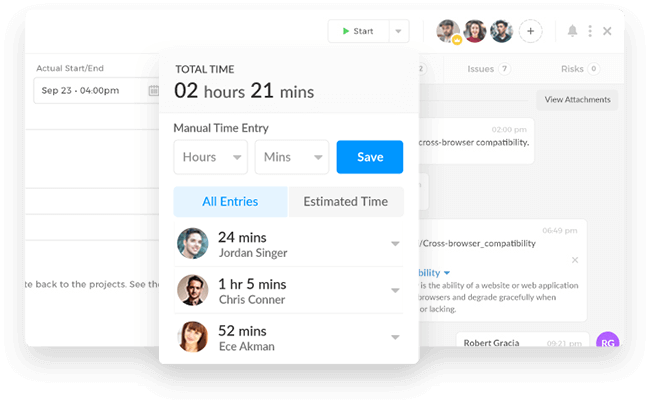Our inability to efficiently manage time often lands us in hot water, with hordes of delayed assignments and fast-approaching deadlines. Keeping up with the daily activities then becomes a Sisyphean task where you do not actually get anything done but are always in the grind with no way out.
While most of us are eager to start and end our daily tasks on time, very few of us are actually able to do that because of poor time management. Even with a set to-do list or proper planning, staying on track is a difficult feat. Fortunately, we have the gift of different time management tools and techniques that aid in improving our time efficiency.
People use different methods and tools to make the most of their time. On average, a person uses around 13 different methods for time management. Among these different methods, one that has proved its efficiency time and again is timeboxing.
Timeboxing is hailed as one of the best methods for time management. The method targets gaps in time management to help you improve your work productivity. Additionally, the technique can help you fight procrastination and narrow your focus for better working.
This article will answer your questions as to what is time boxing and how to use time boxing.
What Is Time Boxing?

As we mentioned earlier, timeboxing is a time management technique. The unique method offers a different approach to time management wherein you allot a specific time to a task.
This method of management can help you focus your attention on the task at hand without any distractions or lapses in the focus. Your goal is to accomplish the task within the specified time limit. There is no flexibility in terms of increasing your time.
Scheduling your tasks into timeboxes significantly improves the time spent on tasks. When you start your timebox, you have to rid yourself of disturbances to make sure you optimize your working during this time and accomplish your goal.
Hard Timeboxes Vs. Soft Timeboxes:
There are two types of timeboxes that you can schedule your work in:
- Hard timeboxes: Hard timeboxes have a rigid limitation where adding a few minutes or even seconds is out of the question. It implies the complete cessation of whatever activity you are performing and moving on to the next task. Hard timeboxes can prove beneficial especially when you aim to improve your efficiency over time. It might take a little getting to come to terms with the method, but gradually you will learn to time your work accordingly.
- Soft timeboxes: In contrast, soft timeboxes are flexible in which you are notified whenever the specified time is up. You can then, make adjustments in your work accordingly. Soft timeboxes can help bring back your focus to the task so that you can speed up your work and complete the task as soon as possible.
Choosing between the two is completely up to you!
How To Use Time Boxing?
How to timebox your tasks? Managing your time through timeboxes is as easy as it seems. Follow the following steps and you will realize how easy and quick it is to manage your time with the timeboxing technique.
1. Create A Timebox for The Items in Your To-Do List
The first step of the technique involves determining the complexity of each task on your to-do list and allocating a timebox to it. You have to determine the approximate time that will be required to complete the task and create a timebox accordingly.
Make sure to leave some time for breaks and unexpected disturbances that may hinder the smooth working. You should have sufficient time to complete the task within the specified timebox.
2. Set A Timer on Mobile or Desktop

Once you have figured out the time you will spend on each task, you can set a timer that will alert you whenever you have to move on from one task to another. The time will help you stay focused so that you can optimize your work performance during that time and accomplish your goal within the specified time.
You can use your phone or desktop for this purpose.
3. Hard Timebox or Soft Timebox
Before starting the timer, you can also decide whether you will go with a hard timebox or a soft one. A hard timebox will work better if you are looking for perfection and are certain that you will be able to complete the task without any delays.
If you are not sure about the time limits or are afraid that it might take more time to complete the task, you can go for soft timeboxes that offer more flexibility. A soft timebox will give you the freedom to adjust your time and keep yourself focused on the task.
4. Start The Timer
Now that you decided everything, the only thing left is to start the timer for the timebox and start working. The end of the time limit does not only indicate the end of the allotted but also notifies you of the impending task that needs your attention. So, make sure to follow the timebox.
5. Evaluate And Revise
Once you have completed your tasks, evaluate your performance and revise your schedule to improve your work efficiency. Take a look at your performance during the day and analyze whether you completed all the tasks on time? Is there any room for improvement? How can you optimize your work?
With each evaluation, you can identify the gaps in the process and develop strategies to enhance your productivity.
All in all, timeboxing is a simple and easy technique. You can easily use the method to make significant improvements in your work.
Benefits Of Timeboxing Your Daily Tasks

Timeboxing has several benefits to offer, some of which include the following:
- Better focus: With specific time allotted to each task, timeboxing can help you focus your attention on the task underway. In such a way, you can also train your mind to stay attentive during the specified time period.
- Better organization: Timeboxing will help you become more organized. Since you have specified a time limit for your work, you’ll learn to organize your tasks in such a way so that they get completed within that time limit.
- Improve productivity: The technique can significantly improve your productivity levels by helping you stay on track and accomplish your tasks within the time allotted.
- Helps deal with procrastination: Timeboxing can be especially helpful if you are dealing with procrastination. The method can help you focus better and invest your time in the task at the right time.
- Prioritizing: With timeboxing, you can learn to prioritize your tasks. The most important tasks go first and are allotted time accordingly while the less important ones go next and vice versa.
- One task at a time: With laser focus and a specific time limit, you can invest your attention in one task at a time. This way you will be able to complete the task within time and then move on to the next one without any hurdles.
- Goal-oriented: Timeboxing is a goal-oriented method, you are not just limiting the time you spend on a task but setting a goal for yourself; your goal is to accomplish the task within time.
- Prediction: With a time limit allotted to each task, you can predict the amount of time you will save yourself or the time you can invest in other tasks.
- Time-saving: Probably the most obvious of all benefits is time-saving. Timeboxing can prove to be especially helpful in managing your time the most efficiently and getting your tasks done in the shortest time.
With all these benefits, timeboxing can help you ace all your tasks within the deadline.
Why is Timeboxing used?
Whenever we talk about the need for timeboxing in any scenario, it all comes down to improving productivity and time management.
Let’s take a look.
1. Time Management
Timeboxing is very important in time management as time management makes it possible to include all of the different elements of your project in your daily schedule, no matter the category that the pieces fall into.
2. Productivity
Productivity and timeboxing go hand in hand as those who opt for timeboxing usually look to ensure they get the most output out of their workday possible.
Human nature is always ready to guide us off the path of improvement, but timeboxing is a surefire way to overcome that feeling.
What is the Difference between time blocking and timeboxing?
As we know what timeboxing is, how it can be done, and its benefits, we should also know about time blocking and how they differ from each other. Let’s begin.
Time blocking

With time blocking, you can allocate specific slots to each task to ensure that you have ample time for everything on the agenda.
This also removes your innate fear about not having time for important things, resulting in them being unfinished.
In this time management technique, the time periods are called time blocks and generally dictate a start and end time for each activity on the agenda. You can easily mark this short time window on your work calendar.
Furthermore, each individual time block is meant to help you follow your schedule and finish your work quickly with time to spare.
When the time block ends, you calculate the time spent on the task in question, and if you didn’t have enough time to complete that task, you just allocate more time to the same task when it is set to be performed in the future.
Timeboxing

In the case of timeboxing, you allocate different time periods to put a strong or strict limit on all activities that can potentially take a lot of your essential work hours.
This time management technique is called timeboxes and may involve more extensive time periods than time blocking. Sometimes, these periods can cover periods from 15 minutes to several months on the calendar.
One thing you need to understand is that a timebox always has definite deadlines, milestones, and goals attached to it. It can involve milestones, a proper budget, and some deliverables attached to it.
At the end of this timeboxing activity, you can declare how much work you have done. Once you have declared that time, you assess whether you were able to meet all of your goals and milestones or if there is some work left to be done.
Tips To Make Timeboxing Work for You:
Before we conclude this article, we would like to add a few tips to make sure that the technique works for you:
- Pre-plan your tasks: Before you start with the process, make sure you have planned everything out. For example, which task will you complete first? How much time will each task need? How can you utilize your time most efficiently? etc. Planning is a great way to kickstart your progress and make the most out of your time.
- Keep Your Timer in Front of You: To keep yourself focused and avoid distractions, keep your time in front of you at all times. The timer will help you analyze how much time you are left with and how you have to make your way around it to make sure your task gets completed within that time.
- Take regular breaks: By taking regular breaks you are not wasting your time but rebooting your system to maintain the same level of energy you had at the start of your day. So, take breaks within each task and between different tasks.
- Avoid distractions: Since you have set a goal for yourself, you ought to make sure that there are no distractions in your way. Set aside a space for yourself where you can work, turn off all notifications, and make sure that there are no other distractors in the way of your work. By doing so, you can increase your efficiency.
- Set similar tasks together: Moving from one task to another can be difficult especially when both tasks are poles apart. To minimize the time spent on refocusing your attention, you can set similar tasks together so that you can quickly get on with the work without missing a minute of your time.
- Use a management tool: If you find it difficult to create a list and create timeboxes manually, you can take help from an efficient time management tool. The tool will help you create tasks with specific time limits. Time tracking features of such a tool will help you keep up with the task.
You can take help from these tips and create efficient timeboxes for your work. These tips will surely come in handy when you are working with timeboxing.
Conclusion:
We hope that this article has answered all your answers related to timeboxing or how it work. What do you think of this technique? Is there any other technique that you use to manage your time? let us know by writing an email to fwilson@ntaskmanager.com. We would love to hear your opinion.
Signing off now!
Sayonara!
More Resources For You:

